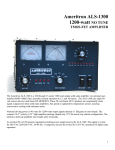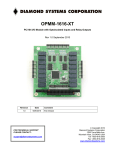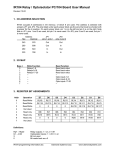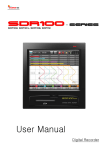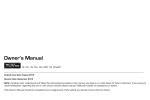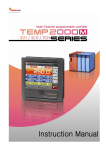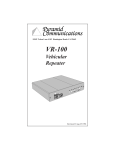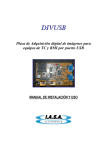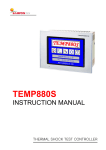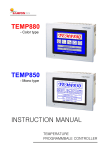Download The Ameritron ALS-1300 is a solid state FET no
Transcript
Ameritron ALS-1300 1200-watt NO TUNE TMOS-FET AMPLIFIER The Ameritron ALS-1300 is 160 through 15-meter amateur radio band 1200-watt output solid-state amplifier. It uses eight 50-volt conservatively rated linear RF MOSFETS. 50-volt linear FET’s designed for transmitting service produce an exceptionally clean signal compared to other solid-state amplifiers. Fan speed is regulated by temperature sensors; assuring conservative cooling with minimum noise. Nominal driving power is 90 watts for 1200-watts output (approximately 11 dB gain) on most bands. The compact 10” wide by 6-1/2” high amplifier package (depth only 18”) fits nearly any station configuration. The attractive desk-top amplifier unit weighs only 22 pounds. An external 50-volt 50-ampere regulated power supply powers the ALS-1300. The supply is wired for 230 VAC (200-260 VAC, 50-60 Hz, 15 amperes), but can be rewired for 120 VAC operation for lighter duty operation. 1 Table of Contents TABLE OF CONTENTS .......................................................................................................................2 AMPLIFIER FEATURES ......................................................................................................................3 POWER SUPPLY .................................................................................................................................4 Power Line Requirements ..................................................................................................................................................................... 4 Power Supply Features.......................................................................................................................................................................... 4 Power Supply Location .........................................................................................................................................................................4 GENERAL INFORMATION ..................................................................................................................5 Amplifier............................................................................................................................................................................................... 5 Power Supply ........................................................................................................................................................................................ 5 INSTALLATION.................................................................................................................................... 5 Airflow .................................................................................................................................................................................................. 6 INTERCONNECTION WIRING.............................................................................................................7 AMPLIFIER REAR PANEL ..................................................................................................................8 FRONT PANEL .................................................................................................................................... 9 OPERATION.......................................................................................................................................10 MARS OR CAP OPERATION ............................................................................................................10 INITIAL OPERATION ......................................................................................................................... 11 CIRCUIT BOARDS.............................................................................................................................12 CB-1.................................................................................................................................................................................................... 12 2 Amplifier Features This amplifier provides the following standard features: Eight conservatively rated, very linear, 50-volt MOSFET transistors Operational in a few seconds, no long filament warm-up time Clean layout with easy-to-service modular construction Front panel indicators including wrong band and other fault errors Quiet variable-speed forced air cooling system Power module balance metering Power module current and voltage metering with LED illumination PEP forward output power and PEP reflected output power metering Reflected power protection Bandswitch error protection Standard negative going ALC output with front panel adjustment control ALC metering and an ALC LED indicator Fully regulated external power supply Compact size 17.5” deep x 7” high x 10.5” wide Weight amplifier section 23 pounds 3 Power Supply The power supply for the ALS-1300 is a voltage regulated current limited supply. It contains 14-volt positive and negative supplies as well as dual 50-volt 25-ampere continuous (30-ampere peak) fully current limited supplies. Each PA (power amplifier) module in the ALS-1300 operates from the separate 50-volt sources, giving a total dc input power rating of 2500 watts to the power amplifier modules. Power supply to amplifier interconnections are through a heavy-duty cable using a large Cinch Jones connector. Power Line Requirements This amplifier ships wired for 200-260 Vac. The maximum average power line current is 12 amperes at 240 volts. Two 250-volt 15-ampere fuses fuse the power line. Note: 120-volt power mains operation is possible with a reduction in CW or RTTY power. Because average power is very low, SSB operation is unaffected by 120 volt operation. Fuse size would be 25 amperes maximum. Power Supply Features Efficient operation from 200-260 volts ac (12 amperes minimum) and 100-135 volts (20 amperes minimum) Wide range of power line frequencies, 40-400 Hz Fully regulated current-limited outputs Step-start to limit stress on power supply components Exceptional filtering and RFI suppression Compact light-weight design Power Supply Location Locate the power supply in a convenient ventilated area near the amplifier location. Do not place the power supply next to sensitive equipment like audio processors, transceivers, or microphones. For safety ground the wing nut stud on the supply rear to the station ground buss. The station ground buss should comply with national electrical codes. These codes dictate that station grounds must be bonded to the power mains entrance ground. A station ground that is not bonded to the mains ground does not offer lightning protection! 4 General Information Amplifier The Ameritron ALS-1300 is a solid-state 1200-watt nominal RF output power 1.8-22 MHz amplifier. This power is peak envelope power, which is the same as actual carrier power on CW. It uses eight exceptionally very low distortion push-pull parallel MRF-150 or equivalent RF power TMOS transistors. The ALS-1300 meets or exceeds all FCC rules governing amateur radio external power amplifiers. Two temperature sensors on each PA (power amplifier) module, with bias tracking FET temperature and fan speed tracking heatsink temperature, control bias and fan speed. Harmonic suppression comes from push-pull operation of linear devices, and a series of high quality 5-pole low-pass filters. This amplifier exceeds all FCC mandated harmonic restrictions. Antenna switching is through a sequenced pair of miniature relays on a plug in board. Relay switching time is approximately five milliseconds. This amplifier’s “relay” jack sources 12 volts when open circuit, and the relay jack current upon closure is less than 20 mA. This amplifier includes two dual-movement cross-needle meters. This is the equivalent of having four panel meters. The left hand meter is a dual power amplifier current meter. The right hand meter continuously displays forward RF peak envelope power on one dedicated scale, while the second movement in the right hand meter switches between reflected power, combiner mismatch voltage, ALC, and each power amplifier’s voltages. While this amplifier will run more than 1200 watts PEP output, linearity will suffer. Ameritron recommends running 1200 watts peak power for maximum linearity, at which point this amplifier will have comparable IM performance to the best vacuum tube linear amplifiers. The characteristics of linear high-voltage FET’s are very much like those of triode vacuum tubes. Power Supply The ALS-1300 has an external power supply. This power supply normally operates from 200-260 volts at 50400 Hz. It connects to the amplifier through a single cable. The power supply should be located in a cool spot away from sensitive audio systems or cables. Installation Please look your amplifier and power supply over carefully. Observe the air inlet and outlet ventilation holes. Locate the air inlet and outlet areas of the amplifier. Facing the amplifier front panel, the cooling air inlet is on the right side. The warm air outlet is on the left side of the amplifier as viewed from the normal operating position (front view). While the outlet air won’t be particularly warm, it is never a good idea to have it blow into heat sensitive equipment such as transceivers or other power amplifiers. Have the same consideration for your new amplifier and power supply. Be sure the air inlet temperature isn’t substantially above normal room temperature. Ideally the air inlet should be kept below 32° C or 90° F, although temperatures up to 41° C or 106° F are permissible. If ambient temperatures exceed these limits it might become necessary to reduce duty cycle or power. Warning: Do not block cooling air inlets and outlets! Never expose the amplifier to water or mist. 5 Airflow The amplifier must have a clear area to the sides and top for proper airflow, and to the rear for interconnection wiring. It is especially important to avoid obstructions that block the air inlet on the top left and both lower sides. Two inches clearance is normally adequate for full ventilation. Keep any papers or loose objects that might impede airflow away from the air inlets and outlets. Locate the amplifier and power supply away from sensitive equipment such as microphones, audio processing equipment, or low level audio or radio frequency amplifiers. Generally the best location for the power supply is below the operating desk and away from antenna feedlines. This will keep fan noise and any RF coupling to a minimum. The power supply is factory wired for 200-260 Vac. It uses a standard NEMA-6-15P 15-ampere 240-volt plug. The round center pin is the safety ground. Do not remove the safety ground. CAUTION! Before connecting the power supply to an electrical outlet, always be sure you have completed the following four steps: 1. Insert the 15-ampere 250V fuses into the two black fuse caps. 2. Insert the fuse and cap assemblies into the power supply’s fuse holders. The fuses lock in place with a slight turn. 3. Connect the power supply to the amplifier. 4. Be sure the amplifier power switch is turned off. Caution! Fuses have both voltage and current ratings. Use only 250V rated fuses in this device. The voltage rating generally is marked on fuses. DO NOT use automotive-type low voltage fuses in any power line application. For 240volt operation 15-ampere fast blow fuses are required. Warning: Never insert the power supply cord into the outlet unless the above four steps have been completed!! Position the amplifier at the desired location on your operating desk, position it so you have access to the rear panel, and connect the rear panel cables. Do not connect the power mains at this time! 6 Interconnection Wiring POWER SUPPLY FUSE ANTENNA, ANTENNA TUNERS, SWITCHES, FILTERS FUSE ALS - 1300 OUT IN REMOTE A B RLY ALC TRANSMITTER / TRANSCEIVER ALC RLY ANT Figure 1 Interconnections INTERCONNECTIONS 7 Amplifier Rear Panel PWR SUPPLY To prevent connecting the power plug wrong, the large black multi-pin connector is indexed by the offset in two round pins. One round index hole is closer to the outer connector edge. Mate the round pins and holes and seat the male plug fully onto the amplifier rear panel pins. ALC Optional connection. Connects to radio ALC input. Mandatory if using a radio over 100 watts. RLY Connect to radio amplifier keying line. Radio must pull this line below 2 volts to transmit. GND Connect to station ground buss. This connection is for safety. IN Connect through good 50-ohm coaxial cable to radio’s antenna output connector. This can be a smaller cable like RG-58/U. OUT To 50-ohm antenna, antenna tuner, power meter. This is the high power output. 50-ohm coaxial cable must safely handle 1200-watts. 1.) Connect the station electrical safety ground to the rear panel wing nuts. National safety codes require the station ground be bonded to the power mains safety ground at the building entrance. 2.) Connect the power supply to the amplifier. 3.) Connect the RLY line to the transceiver’s accessory RELAY or XMT port. This port must pull low for transmit, and be open circuit when receiving. Relay control voltage from the ALS-1300 is 12 volts positive with only 15 mA current. You should always check your transceiver’s manual, but almost any standard transceiver directly interfaces to this amplifier. 4.) Connect the OUT (output) port to the appropriate point in your station. This is the high power RF output cable. This connection would go to your 1500-watt rated Power/SWR meter, antenna, or antenna matching device. Good quality Mini-8 or RG-8X cables are acceptable for anything but RTTY use, although larger RG-8 style cables are normally preferred. Your antenna matching system must connect to this port. 5.) Connect the IN connector to your transceiver. Do not install any active antenna matching devices on this port. In general the shortest and most direct cable connection is best, although high quality cables can be very long without adverse effect on performance. RG-58/U or Mini-8 (RG-8X) style cables are acceptable. You should never use a tuner of any type on the amplifier input, nor should you drive this amplifier with over 100 watts peak envelope power. Never use a non-FCC accepted device with this amplifier. 6.) The ALC line is optional. In general the internal ALC in the transceiver is all that is needed. The ALC monitors the RF output power and reflected power supplied by the ALS-1300 to the load. 7.) Operate the bandswitch manually during initial testing. Do not connect band decoders or computer interfaces until initial tests are completed. 8 Front Panel Figure 2 Amplifier Front 9 Operation This amplifier is very simple to operate. Once you have established proper connections please set the amplifier (Fig. 2, ref 3) to one of the following bands: Band 160 80 40 30 20 17 15 12 10 Frequency Range 1.8 - 2.1 MHz 3.2 - 4.2 MHz 6.0 - 7.5 MHz 7.5 - 14.0 MHz 13.5 – 14.5 MHz 14.5 – 19.0 MHz 19.0 – 22.0 MHz 22.0 – 25.0 MHz 28.0 – 30.0 MHz Notes Operation locked out in domestic model. Export Only. Operation locked out in domestic model. Export Only. Operation locked out in domestic model. Export Only. Caution: This amplifier is not suitable for 27 MHz. Damage to expensive components such as power amplifier transistors will occur if attempts are made to use this amplifier in the 25-28 MHz frequency range. MARS or CAP Operation For licensed amateur radio operators participating in Military Affiliate Radio Systems, this amplifier is suitable for MARS and CAP operation on all frequencies between 1.8 and 22 MHz with some precautions. The upper frequency limits are in bold type in the table above. Do not operate above the bold-type frequency limits in the table above or PA (power amplifier) damage may occur. It is permissible to operate below those limits if you provide additional external harmonic suppression for authorized services such as MARS and CAP. When operated outside the frequency limits above, harmonic suppression might not meet acceptable limits. You may have to use additional external 2nd harmonic filtering. Ameritron guarantees to exceed FCC part 97.307 harmonic suppression standards only inside the frequency ranges listed above. Contact Ameritron with your specific requirements. Ameritron requires proof of a valid MARS or CAP license as well as your own amateur radio license for technical assistance. 10 Initial Operation Double check all wiring and connections (fig. 1) before turning power on. It always pays to be safe. If you are sure you have connected your amplifier correctly, follow the procedures below. The following steps only need to be done on an initial checkout: 1. Place the MULTIMETER switch (fig.2 ref 7) in the HV2 position. Place the ALC SET control (fig2. ref 5) full clockwise (10 on scale). 2. With the STANDBY/OPERATE switch (fig.2 ref 8) on STANDBY, turn the power switch (ref 9) ON. 3. There will be a slightly delayed click from the power supply. HV2 (fig.2, ref 2) should immediately rise to nearly full scale, and after a slight delay you should hear another click. The meters and BAND LEDS (fig.2, ref 4) will light up. 4. The HV meter (fig.2, ref 2) should read between 45 and 55 volts. 5. Change the meter switch (fig.2 ref 7) to HV1. The voltage should be the same as in step 4. 6. Rotate the BAND switch (fig.2 ref 3) through all positions. For any model purchased in the USA, only the 160, 80, 40, 20, 17, and 15-meter bands will actually operate. 7. Change the meter switch (ref 7) to REF. This will read reflected power. 8. With no modulation in the FM, AM, RTTY, or CW mode adjust your exciter power to low power, around ten watts. This is to have a steady unmodulated carrier. Verify you have very low power, ideally around 10 watts carrier (not critical), and that VSWR of the antenna system is low. You should see almost no deflection on the reflected power scale (fig.1 ref 2). If you see reflected power deflection, check your RF cables. Note: You cannot use a tuner in your radio or between your radio and this amplifier to match the antenna system. Any antenna matching must be between the amplifier and the antenna, and the antenna tuner must be safely able to handle at least 1200 watts of carrier or peak envelope power. 9. Place the amplifier in OPERATE position (fig.2 ref 8). Be sure the BAND on the amplifier matches the band selected on the transceiver. 10. Place the transmitter or transceiver into transmit in FM, AM, RTTY, or CW modes. The green TX LED (fig.2 ref 6) should light. The forward power (fig.2 ref 2) should increase to approximately ten times the initial reading, the reflected power should remain low, and the PA current should increase slightly on both scales of the current meter (fig.2 ref 1). No other lights should illuminate. 11. Briefly increase power to 1200 watts output. 12. After you have verified all of this, the amplifier is ready to operate. 11 Circuit Boards There are 10 basic circuit boards plus two power amplifier modules in the ALS-1300. The text below gives a brief description of each board’s function. 2KWF The 2KWF is a high power low pass filter. It is the very large board with large toroid and a few air wound inductors. This board contains filter SWR fault detection, power amplifier unbalance detection, and multiple high power low pass 5-pole filters. Additionally two smaller boards, the antenna relay board RLY and the PA combiner board CMB, attach directly to the low pass filter board. BS1 The BS1 is located behind the BAND switch. It provides all band selection functions as well as band indicators. CB1 The CB1 is located near the front of the amplifier just behind the meters. The CB1 control board provides most control functions. This includes bias, fan speed, overload protection, and transmit-receive relay sequencing. It is the hub for nearly all functions, including interfaces. CMB This board combines the outputs of two 600-watt PA modules. It is a traditional 50-ohm “magic T” combiner with an output-matching transformer. FL10 The FL10 is optional and only appears in export models. It enables ten meter and twelve-meter operation. MB-1 The MB-1 is located behind the front panel below the meters. It contains peak-envelope-power detection circuits, multi-meter switching, fault indicators, and ALC circuits. There are four power meter adjustments on this board, two for calibration of forward and reflected power and two for forward and reflected peak hold time. Shunts on a header located on the board’s upper edge adjust panel meter brightness. PA Boards PA boards are located on top of the heatsinks under the filter board shield panel. There are no user adjustments on these boards. PD8 The PD8 is located on the right side of the amplifier just above the panel containing the cooling fans. It contains a power splitter and two 5 dB attenuator pads. The splitter and attenuator pads isolate the two power amplifiers from each other, and terminate the PA inputs in 50 ohms over a wide range of frequencies. This is necessary to stabilize the PA modules. Do not remove or bypass the attenuators. 12 RJ45 The RJ45 board mounts on the rear panel. It contains two RJ-45 jacks for remote control interface. RLY The RLY board contains two transmit and receive relays, one for RF output switching and the other for RF input switching. T/R relays activate with a low on terminals K (key) J1-3 and RJ1-7. The CB1 board contains the relay timing controls. SWR The SWR board is on the rear panel in front of the RF output connector. It is a traditional 50-ohm directional coupler. The null adjustment is accessible through a rear panel hole. Schematics Filter 2KWF 2KWF-1R1 081210 PA Comb Out PA A PA B Gimmik T2 T1 C99 RLY1 C1 1500 D1 1N916 C28 270 R4 10k C98 10pf D2 1N916 RLY5 R3 1k J2 L7 8T C13 270 RLY9 J4 C10 360 C6 680 C11 C15 C14 270 C19 180 L6 12T 360 270 C17 FL 10 Rly L9 6.5T C7 680 180 RLY11 Ant L5 12T 360 C29 .01 L3 11T C2 C3 1500 1500L4 11T C9 50 RLY7 R1 1k L2 16T C5 680 R2 C21 .001uf RLY3 L1 16T L8 8T L10 6.5T C18 180 12VDC RLY2 C4 RLY11 1500 RLY2 RLY4 C8 680 RLY6 C12 360 RLY3 RLY4 C23 .1 RLY6 C24 .1 RLY8 C25 .1 RLY10 C26 .1 RLY12 C27 .1 RLY5 RLY8 C16 270 RLY7 RLY10 C20 180 RLY9 RLY12 FL10 FL 10 RLY11 C22 .1 J3 J1 Gnd 160 80 40 20 15 10 Gnd PA Out Rly PA IN RADIO rev 03 Mar 2009 Figure 3 13 Bandswitch BS1 BS - 1 LED1 160 LED2 80 D1 1N4001 D2 1N4001 D3 1N4001 J1 G 160 80 40 20 15 10 12V D4 1N4001 J2 D5 1N4001 +12V Remote J3 G 160 80 40 20 15 10 12V D6 1N4001 R1 1k 80 2 40 30 / 3 4 20 1 LED3 40 160 +12V LED4 30 LED5 20 5 17 SW 1 rear view 9 6 7 15 12 8 10 LED6 17 LED7 15 LED8 12 LED9 10 +12V 7 July 2008 Figure 4 14 Control Board CB1 CB1 rev2.1 090227 R1 1k ZD1 R59 10k 5.1v J1 G + K F R REAR PANEL A F1 1A TO MB J1 FILTER U4pin8 U4pin4 DC12V VR10 25k 40% R8 1k .01 5 6 3 2 R2 100 1A G + F R T P S A CL C1 .1/50v F2 DC12V C2 .1/50v R11 100 R5 100 J2 U1pin4 U1pin11 S R4 100 J5 R10 100 R3 100 C4 10k R58 R17 1k C3 .1 12 8 U1B U1A 1 7 10 13 11 D3 14 1 D2 CLK 5 U1D 13 R29 27k R16 4.7k D4 D6 16 C16 .1 Q1 3906 R26 4.7K LM358 U4A 3 D9 R28 100 D7 D5 DC12V DC12V R57 1k 4042 U3 7 2 R9 10k R7 1k G CL S G 2 1 X X C6 .1 C9 .1 R12 10k C8 .1 R6 100k 6 C14 .01/50v R21 6.8k Q4 3904 DC12V R22 1k R15 10k R18 10 RL2 ANT R20 6.8k R14 10 RS T P S S S R13 1k Q5 2955 RL1 INP 4.7k C22 .47 Q2 2955 Q3 3904 C7 .01/50V R19 10 R23 1k LM358 U4B 7 R24 5 C10 .01 R25 4.7k C15 .47 R27 4.7K D8 1 C5 .01 RJ1 J4 GND 160 BAND FILTER F K 10 GND C13 .1 RL2 ANT FAN J7 RL1 INP DC12V R33 4.7k G S S X X C27 .1 C26 .1 C25 .1 C24 .1 C23 .1 14 13 DC12V Switched R32 10k U2pin4 U2pin11 R31 4.7k C35 .1 R40 4.7k R41 10k 3 2 U2A 1 FB R37 2.2k Q7 3055 R35 1k C21 +.47 R38 10k R34 10k FAN C19 .1 160 BAND SWITCH FAN R30 1k R36 2.2k C18 .1 9 U2C IN R42 5 6 U2B 7 R45 1k R51 4.7k Q8 3906 Bias B R50 10K C31 .47 + 1k 40% 1k 40% VR1 VR2 R53 100 J8A J8B HS FET 1k 40% VR4 DC12V Q12 Bias SW Bias B R49 4.7k R48 10K C30 R54 100 C33 47/50v VR5 1k 40% VR6 1k 40% HS FET Bias A Q10 3904 .47 R55 100 C28 .1 1k 40% VR3 C17 .1 Q11 3904 Bias B 47/50v C32 R52 1k 3055 Bias A C29 .1 916 D10 OUT Bias A R44 1k C34 .1 U5 LM7809 DC12V Q9 3906 1k R47 1k 4.7k + Q6 3055 R46 8 DC12V R43 10k 10 C20 + .47 10 J3 DC12V + STBY MISC U2D 12 + J6 FA + C11 .01 R39 10k + C12 .01 VR7 1k 40% VR8 1k 40% C36 .1 R56 100 C37 .1 Figure 5 15 Combiner 2000 watt CMB CMB 081217 rev0a T5 T6 50 OHMS IN PA A 100 50 OHMS IN 50 OHMS OUT PA B Figure 6 Filter FL10 FL10 081210 L1 1 In C1 130pF C2 130pF L2 1 C3 130pF Out C4 130pF Figure 7 16 Metering Board MB1 FWD SPEED -12V REF SPEED R15 1m 40% R5 10k LM324 8V U1A 3 2 4 11 R18 4.7k D3 1N916 D1 1N916 1 C8 R6 1m .01 CTRL J1 D2 1N916 U1B 5 C3 7 6 R9 10k CAL 8V R2 2.5k 40% + R20 4.7k R16 1m 40% 2.2 PIN 1...GND 2...12 3...12 + 4...FW D PW R 5...RFLCTD PW R 6...TRANSMIT LED 7...COMBINER LED 8...SW R LED 9...ALC VOLTAGE OUT 10...COMBINER LVL R3 5.6k C2 .1 D6 1N916 D9 1N916 D5 1N916 -12V D8 1N916 R37 1k 8V R17 4.7k R35 100k C9 12 D4 U1D 1N916 13 10 14 R8 1M .01 C4 8 R1 2.5k 40% C1 .1 2.2uF +12 R28 10k 3 C10 R26 560 .1 U2A 2 R33 220k ALC R39 -12V CTRL 10k 10% R12 10 J1 U2B LM358 8 5 R27 7 6 1k 4 D4 LED4 R31 1m D7 1N916 C11 .1 R30 6.8k R32 1k C7 .1 3 5 R10 68K 10 R R11 68K C13 .1 9 C V2 6 A CURRENT J3 CURRENT J3 V1 + SW 1 METER BRIGHTNESS 8 7 PIN 1...V2 2...V2 3...V1 4...V1 J4 .1 R25 1k Gn d + Fwd Ref T C S A CL Gn d F + L G R7 10 C5 C6 .1 J2 11 - A V1 R4 5.6k V2 C 4 R21 100 R19 10 12 R 2 PIN 1...GND 2...FW D 3...MM 4...MM + 5...LMP 6...GND MULTI METER C12 .1 1 R29 1k 1 MULTI METER J2 REF CAL U1C 9 + R36 1k R34 220K +12V R13 1k R14 1k +12V METER BRIGHTNESS J4 1,2 low 2,3 high R38 4.7K C16 .1 R22 1k R23 47k R24 47k Q2 C15 2N3904 .1 R41 1k D1 LED3 Q1 C14 .1 2N3904 R40 1k D2 LED2 D3 LED1 C17 .1 MB1 Rev3 090227 PEAK METER / ALC Figure 8 17 PA Boards PAM-600 Yel C4 .1uF C1 00 R2 NTC Org R8 18 18R10 PA In R13 P1 T1 C10 470pF CONN Red C6 .33uF C7 .33uF R7 1k R9 1k Q2 1 R11 C8 .1uF C11 330pF 18 R19 C3 470pF Q1 R6 18 C5 .1uF R1 NTC C2 .001uF 1 R4 18 R3 .1uF R5 470 PA Out 081217 Revision 0a 22 R14 22 R15 22 R16 22 R17 22 R18 22 R12 C9 470 .001uF T3 X1 T2 R21 C13 470 .001uF T4 C23 .33uF Q3 1 R20 C24 .33uF FB2 V1 Red C12 .1uF C14 .1uF R22 18 C17 .33uF C15 R24 18 .1uF Brn C16 .33uF 18 R26 R23 1k C21 .33uF Q4 R28 C22 .33uF 50VDC C25 .47uF C26 100uF R25 1k 1 R27 C18 .1uF FB1 C20 470pF C19 470 .001uF Figure 9 Power Divider PD8 100 R7 T2 R2 27 Out R1 200 R3 200 R5 27 R4 200 T1 Out R6 200 PD8 rev0 -8db splitter In 081126 Figure 10 18 Interface Connections RJ45 RJ45 Rev0 090217 Pin8 J1 Pin6 Pin7 - - Pin4 Pin5 Pin8 Pin2 Pin3 Pin6 Pin7 Pin1 J2 Pin4 Pin5 Pin2 Pin3 Pin1 R2 560 1/2W D1 D2 R1 1k C1 0.1uF J3 CONN Figure 11 19 Relay Board HD1 RLA 081210 HD4 PA IN RADIO RL4 ANTENNA PA OUT RL1 MAY 21, 2008 Figure 12 Reference figures and drawings Figure 1 Interconnections ....................................................................................................................................... 7 Figure 2 Amplifier Front......................................................................................................................................... 9 Figure 3 ................................................................................................................................................................. 13 Figure 4 ................................................................................................................................................................. 14 Figure 5 ................................................................................................................................................................. 15 Figure 6 ................................................................................................................................................................. 16 Figure 7 ................................................................................................................................................................. 16 Figure 8 ................................................................................................................................................................. 17 Figure 9 ................................................................................................................................................................. 18 Figure 10 ............................................................................................................................................................... 18 Figure 11 ............................................................................................................................................................... 19 Figure 12 ............................................................................................................................................................... 20 20




















